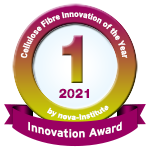 2nd International Conference on Cellulose Fibres will be all about the fastest growing fibre group in textiles, the largest investment sector in the bio-based economy and the solution for avoiding microplastics from textile washing. With 210 participants and 15 exhibitors from 26 different countries, the 1st International Conference on Cellulose Fibres in February 2020 was a great success and exceeded all expectations.
2nd International Conference on Cellulose Fibres will be all about the fastest growing fibre group in textiles, the largest investment sector in the bio-based economy and the solution for avoiding microplastics from textile washing. With 210 participants and 15 exhibitors from 26 different countries, the 1st International Conference on Cellulose Fibres in February 2020 was a great success and exceeded all expectations.
Michael Carus, CEO of nova-institute and initiator of the conference stated: “The first conference on cellulose fibres hit the mark. We have given the growing industry an ideal platform for exchange and networking. Due to the extremely positive feedback, we believe that we will be able to attract even more experts from the cellulose fibre sector for the second event.”
Building on this success, the 2nd International Conference on Cellulose Fibres will again cover the entire value chain from the lignocellulosic feedstock over dissolving pulp, cellulose fibres – such as rayon, viscose, modal and lyocell and new developments – to a wide range of applications like woven textiles (clothing) and non-wovens (wipes and technical applications). All these sectors have gained significant momentum over the last few years.
Cellulose fibres are a success story within the textiles market with a compound annual growth rate (CAGR) between 5 and 10% over the last ten years – similar growth rates are expected in the next decade. This makes cellulose fibres the fastest growing fibre group in the textile industry and also the largest investment sector in the global bio-based economy. The challenge now is to achieve a balance between the ongoing capacity expansion and the growing demand – to avoid over capacities, but also to cover the increasing demand of the big brands.
These high growth rates are driven by the demand for natural fibres (and bottlenecks in cotton), the microplastic problematic and looming bans for plastic fibres. All three drivers will continue to play a significant role in the future development of the sector, as well as alternative cellulose feedstocks obtain from side-streams and recycling. These can reduce the demand for virgin feedstocks, even though the overall demand for cellulose fibre will further increase.
For the first time the innovation award “Cellulose Fibre Innovation of the Year” will be granted on the conference
 The innovation award “Cellulose Fibre Innovation of the Year 2021” will be granted to the innovative cellulose fibre industry for the development of new technologies and applications. All producers and inventors along the entire value chain from feedstock to final product are invited to enter the competition. An expert jury will select a total of six new materials and products from all entries for the award. After short presentations of the six candidates at the conference, the three winners will be elected by the participants of the conference and honoured with the innovation award at a festive gala dinner.
The innovation award “Cellulose Fibre Innovation of the Year 2021” will be granted to the innovative cellulose fibre industry for the development of new technologies and applications. All producers and inventors along the entire value chain from feedstock to final product are invited to enter the competition. An expert jury will select a total of six new materials and products from all entries for the award. After short presentations of the six candidates at the conference, the three winners will be elected by the participants of the conference and honoured with the innovation award at a festive gala dinner.
Call for abstracts, innovation and sponsors are open now. Lenzing, Levaco Chemicals and Kelheim Fibres will support the conference as gold sponsors. Further sponsors are welcome. As partners, the conference will be supported by CLIB, The Fiber Year Consulting, C.A.R.M.E.N, Textile Exchange, the Russian Textile Association, the World Bioeconomy Forum and the Institute of Textile Technology of RWTH Aachen University.
You will find all information about the conference here: www.cellulose-fibres.eu
Source
nova-Institut GmbH, press release, 2020-10-05.
Supplier
ATP - Russian Textile Association
C.A.R.M.E.N. e.V.
Cluster Industrielle Biotechnologie e.V. (CLIB2021)
Institut für Textiltechnik (ITA) – RWTH Aachen
Kelheim Fibres GmbH
Lenzing Gruppe
LEVACO Chemicals GmbH
nova-Institut GmbH
Textile Exchange
The Fibre Year Consulting
World Bioeconomy Forum
Share
Renewable Carbon News – Daily Newsletter
Subscribe to our daily email newsletter – the world's leading newsletter on renewable materials and chemicals









